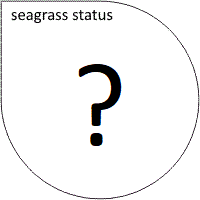Turks and Caicos Islands
The Turks and Caicos Islands are located in the Tropical Western Atlantic and in large parts share Caribbean fauna and flora, biogeographically they are often related to the Bahamas. Seagrass meadows in the area have not been well documented; they are primarily located in channels protected by fringing reefs on the east and north coast and on the south westerly located Caicos Bank, an extensive shallow area. Species of seagrass commonly found in South Caicos are Thalassia testudinum, Syringodium filiforme and Halodule wrightii and the rarely encountered, Halophila engelmanni1.
The island has only a few hundred people as residents and the major income is fisheries for Queen Conch (Strombus gigas) and the Caribbean Spiny Lobster (Panulirus argus), reef fishes are only fished for on a small scale.
Seagrass-Watch in Turks and Caicos
To provide an early warning of change, long-term monitoring has been established in Turks and Caicos as part of the Seagrass-Watch, Global Seagrass Observing Network (www.seagrasswatch.org). Establishing a network of monitoring sites in Turks and Caicos provides valuable information on temporal trends in the health status of seagrass meadows in the region and provides a tool for decision-makers in adopting protective measures. It encourages local communities to become involved in seagrass management and protection. Working with both scientists and local stakeholders, this approach is designed to draw attention to the many local anthropogenic impacts on seagrass meadows which degrade coastal ecosystems and decrease their yield of natural resources.
Location
South Caicos
Three subtidal monitoring sites were established on South Caicos.
Site 1: a shallow, well protected bay area adjacent to a fringing reef where a large hotel is under construction and part of the seagrass in front of the beach has been dreged (East Bay)
Site 2: close to the fishing docks affected mainly by anchoring boats (Dock)
Site 3: an area within the Admiral Cockburns Land and Sea Park which serves as a control site (SE Long Cay)
Monitoring: suspended
Principal watchers: Centre for Marine Resource Studies
Location: fringing reef flat at Sanur.
Site code: CA
Issues: coastal development, vessel movement, stormwater and urban runoff

- average seagrass cover ranged from 50 to 81%, and was significantly different between sites.
- seagrass cover and canopy height was consistently higher at the Dock site and did not differ between sampling events.
- seagrass cover and canopy height at both the East Bay and SE Long Cay sites increased significantly in spring (2011).
- macroalgae was significantly higher at the Dock site, providing further evidence of possible elevated nutrients.
- macoralgae abundance decreased at the control site (SE Long Bay) in 2011, however remained similar between sampling events at both impact sites.
Seagrass cover, species composition
Interactive plots with mouse-over features providing additional detail
Banner image: Thalassia testudinum. Copyright AKramer